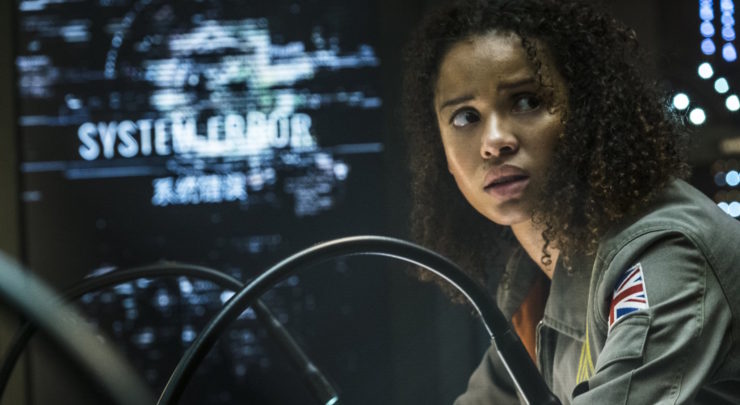Ten years ago, all J.J. Abrams’ company Bad Robot had to do was tweet a date (1/18/08) and a poster with something lurking over New York City, and fans were hooked months before the found-footage sci-fi movie came out. But while the past decade has seen two more installments ostensibly existing in the same Cloverfield mythos, each one’s release has been handled more unevenly than the last: 10 Cloverfield Lane was announced a mere two months before it came out (to mostly positive reviews), and then there was the film formerly known as God Particle. A science fiction thriller with Abrams’ stamp, it was delayed over and over, losing its release date to the untitled third Cloverfield film until Netflix dropped a shocker on Super Bowl Sunday: God Particle was actually The Cloverfield Paradox, and fans could stream it immediately following the game.
But while the method of delivery evoked breathless excitement over social media, the actual movie—about what happens when you smash together two realities—falls far short. Oh-so-ironically, it’s because it mirrors its own plot too well: The Cloverfield Paradox could be a creepy space horror thriller, or it could fill in some key blanks about that monster attack in New York City ten years ago. Attempting to embody both realities just leaves the movie spinning off into the far reaches of the Cloververse.
Spoilers for The Cloverfield Paradox.
It’s 2028, and the bad news is that Earth is in the throes of an energy crisis causing long lines at gas stations and random blackouts. But the good news is that all of Earth’s nations have banded together to launch the Cloverfield Station, staffed with a multinational crew united by the Helios project, which will test the Shepard particle accelerator. Too dangerous to fire up on Earth, the Shepard will hopefully provide unlimited energy for the entire planet. That is, if it doesn’t unleash what conspiracy theorists call the “Cloverfield Paradox”: every test of the particle accelerator having the potential for “smashing together multiple dimensions, shattering reality” not just on the station, but everywhere. According to author Mark Stambler (any relation to Tagruto employee-turned-survivalist Howard Stambler from 10 Cloverfield Lane?), “This experiment could unleash chaos, the likes of which we’ve never seen: monsters, demons, beasts from the sea…”
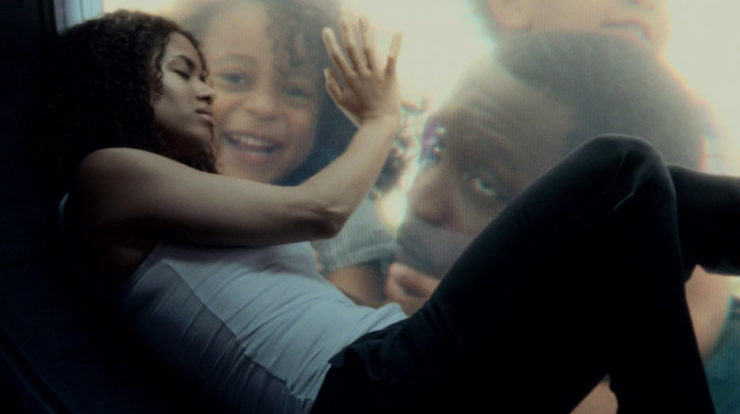
But two years and dozens of fruitless trials later, with just three more attempts to go before the Shepard is deemed a complete failure, Ava Hamilton (Gugu Mbatha-Raw, who has explored other dimensions in Black Mirror and the upcoming A Wrinkle in Time) and the rest of the crew doubt that they’ll be able to fulfill their mission. When they finally get the Shepard working, several things happen at once or shortly after: the system overloads, the station experiences a power surge…
Oh, yeah, and Earth is nowhere to be seen.
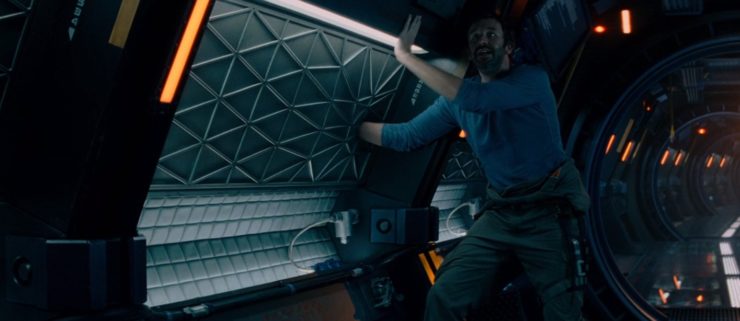
Seemingly stranded in space, the Helios crew discovers a number of eerie goings-on within Cloverfield Station. For one, there’s a stranger, Mina Jensen (Elizabeth Debicki), stuck literally within the walls of the station, power lines fused in and through her skin. Weirder yet, after they cut her out of the wall, Jensen knows all of the crew members—except for engineer Tam (Zhang Ziyi), as Jensen is the sole engineer on her crew—and insists that Ava wasn’t supposed to be on this mission. Then the rest of the crew starts acting strangely: Schmidt (Daniel Brühl) is supposedly a German spy; Mundy’s (Chris O’Dowd) arm gets sucked into the wall, but he’s left with a cleanly cauterized and long-healed stump, and a limb thumping along on its own; Volkov (Aksel Hennie) mutters to himself, prints a 3D gun to kill the others, then dies gruesomely as worms promptly erupt from every orifice.
It’s not a haunted ship, or an alien experiment gone wrong… It’s the Cloverfield Paradox at work. Because when the Shepard accelerator succeeded, it sent Cloverfield Station into a parallel dimension, colliding with another Cloverfield Station on its own mission—where Jensen came from. Now the two realities are grappling for dominance, with the crew members caught in a bizarre body horror narrative that evokes Final Destination, but in space: a higher force is trying to reconcile what was supposed to happen with what did happen, and is remolding each of the astronauts to fit that canon. Thus, Mundy has no arm, Jensen replaces Tam (which we glimpse in a different version of the crew portrait), and so forth. Some of the crew are simply unlucky in where they were positioned when the paradox hit: Jensen got teleported into the wall, while Volkov got the station’s gyroscope and the ship’s collection of worms teleported into him.
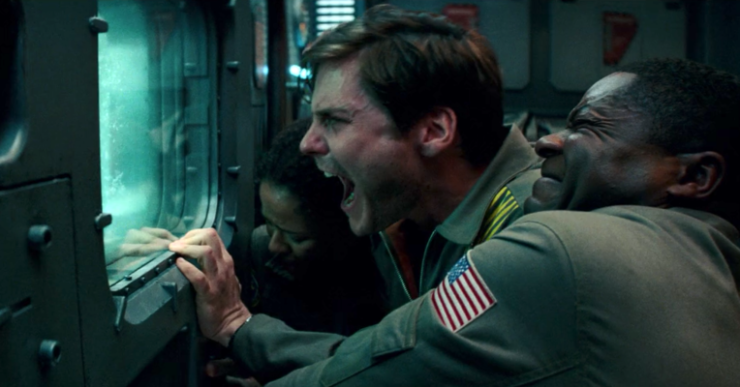
If this had been the narrative route that Paradox stuck to? It could have been great. There’s a scene of Tam drowning in a flooded chamber—inexplicable, until you realize that in this alternate universe, the station exploded and debris crashed into Earth’s oceans. Because Earth hasn’t gone missing; the station just wound up on the other side of the Sun. But the Earth below them is a complete alternate universe in which the Shepard experiment’s failure hastened a world war over energy that has been raging for over a year. But it’s not all bad: Ava discovers that her children, dead of a freak accident in her reality, are still alive down on this alternate Earth, and so considers hijacking her other self’s life. And Jensen grimly informs the ship’s doctor and spiritualist Monk (Chris Ortiz) that she does not wish to return the Shepard to their dimension, as hers needs it more. These are all the kinds of specific, personal dilemmas we’ve seen played out in independent sci-fi films like Coherence or Another Earth… but perhaps there’s a reason why that plot fits better with indies than big-budget sci-fi thrillers. Because instead, Jensen grabs Chekhov’s Volkov’s gun and goes on a killing spree. I’ve seen Cylon sleeper agents with more convincing face-heel turns.
Ultimately the point of The Cloverfield Paradox is to get back to Earth—the original one, or at least the Earth where our story began. It’s clear with the seemingly superfluous plotline about Ava’s husband Michael (Roger Davies), grimly chugging along in energy-crisis-mode society, only to be called into action when a mysterious accident leaves buildings leveled, a child crying in the rubble, and a huge ominous shadow roaring in the wreckage (gee, what ever could it be).
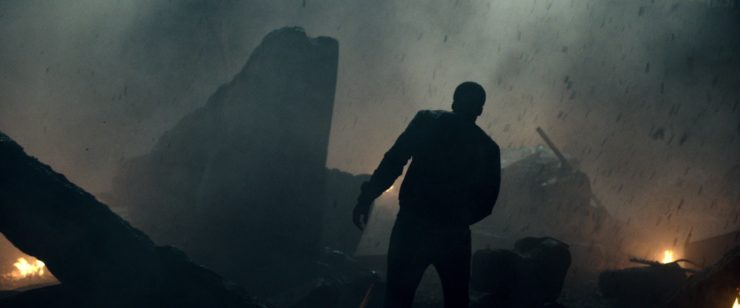
While it may seem like Michael is getting some redemption by rescuing a child, it’s a hollow emotional beat, the same as Ava’s eye-rollingly symbolic shooting of the video of her alternate-universe family in order to suck Jensen into space, because it’s just playing for time until the ending. Michael’s sole purpose is to deliver the film’s final Shyamanesque (and that’s an insult to M. Night, even at his most head-scratching) “twist”: When he gets the phone call that Cloverfield Station has reappeared in orbit and its two survivors—Ava and Schmidt—are en route to Earth in an escape pod this very second, he screams at the caller to “Tell them not to come back!“
Why? Because a gargantuan Cloverfield monster (we still don’t have a better name for them) comes roaring out of the clouds right after the capsule lands.
Again—if we were watching a sci-fi thriller all about the protagonist’s desperate return to Earth, only for her husband to scream at her to stay away, that could be an excellent reversal. But because God Particle was rebranded as a Cloverfield film, all the ending does is raise questions that the movie has no way of answering. Did the Cloverfield Paradox fulfill Stambler’s prediction and yank this monster out of the sea, or out of another dimension? Are we to believe that this is the first time humanity has encountered a monster like this, and that the 2008 attack on New York City just didn’t happen in this reality?
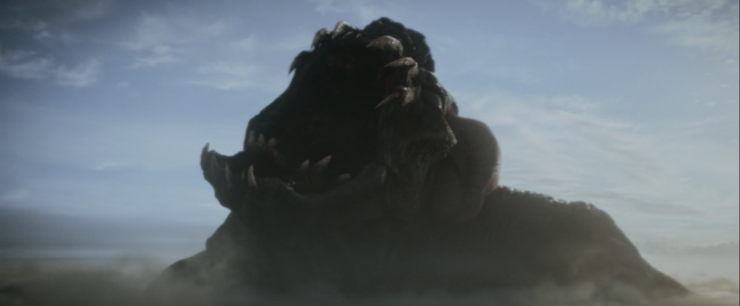
The frustrating thing is, there are just enough details in Paradox to mirror the original Cloverfield without actually fitting alongside it. Sharp-eyed fans aided by the alternate reality game (ARG) created for the 2008 film deciphered its ambiguous ending: the final frames of the home video that make up the found-footage conceit show something falling out of the sky into the ocean, where we now know it woke up a poor baby kaiju that went on a reactionary rampage that ended with NYC being leveled.
There’s plenty of space debris striking water, and there’s the same breed of monster… but it’s not 2008, it’s 2028, and the monster not only looks like the original Clovie’s mom, but it precedes the capsule’s arrival. It’s so close, but it doesn’t actually line up. If Abrams and co. had wanted to make the Cloverfield Station capsule the space debris, that would have closed the loop between those movies in a perfectly understated way… but there’s a 20-year time difference, an energy crisis, and monsters rampaging even before Ava returns to Earth. Some Redditors have made the argument that one of the alternate universes in which the station exploded right after the Shepard experiment and sent debris careening into the ocean (remember Tam’s fate) could have been the culprit… but again, you’ve got an inexplicable 20-year gap, unless there’s some sort of sneaky retcon at play.
Now, this movie deals in multiverses, so it would appear they’re trying to play out the same general elements in different orders and different timelines… but what’s the point? That no matter the universe, Cloverfield Station’s smashing together of multiple dimensions is the inciting incident for conjuring up kaiju? (Or, in the case of 10 Cloverfield Lane, inviting aliens to invade?) That’s just not enough to either answer pressing questions from a ten-year-old movie or lay the groundwork for a franchise.
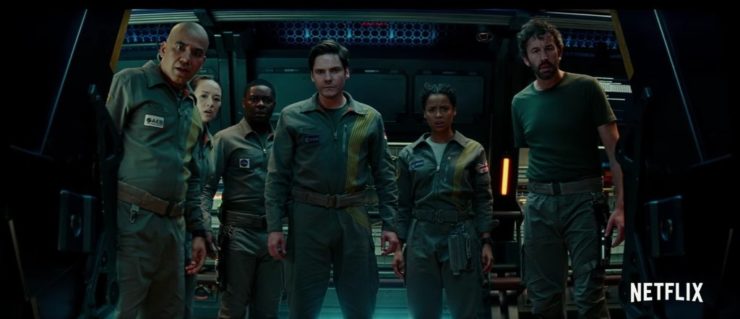
The main problem is that the original film was such a good standalone. Yes, there was plenty of viral marketing and alternate reality games to fill in the gaps, about the monster being a poor baby, what Slusho has to do with all this, etc. But as a film, it had a clear beginning, middle, and downright devastating end. Worse, the two sequels weren’t originally written to be Cloverfield movies: A confined thriller script called The Cellar got retrofitted to become 10 Cloverfield Lane, while God Particle was an entirely separate project. There’s a fascinating Reddit thread from someone who attended a test screening of God Particle in late 2017 and can attest that none of the Cloverfield elements existed; they were grafted on, just as they were to 10 Cloverfield Lane. It’s one thing to introduce a new piece of information at the very end, like in Shyamalan’s The Village—but that movie is filled with sly hints and clever details that support the new dimension. Here, it’s just a hatchet job.
A movie like this needs the core story to be compelling enough to stand on its own even without that final twist. If you turned off 10 Cloverfield Lane before the last few minutes, you still get a gripping tale of a woman escaping the false reality created by a man who controls his domain so totally as to gaslight victims like her. Unfortunately, like Final Destination, the space horror portion of this film is populated by cardboard characters who are merely the victims of greater forces, as opposed to complex characters whose personal experiences have any bearing on their particular situation. And because of how abruptly its space horror plot gets cut off, with a number of plot threads just left dangling like poor Mundy’s arm, The Cloverfield Paradox could not have survived as just God Particle.
And when you go the other direction, where The Cloverfield Paradox is just a complicated setup to a monster-sized punchline… well, unlike that capsule, it just doesn’t land.
Natalie Zutter would’ve been happy to hurriedly binge Cloverfield movies if there had been an actually good sequel to look forward to. Talk better horror SF and multiverse movies with her on Twitter!










